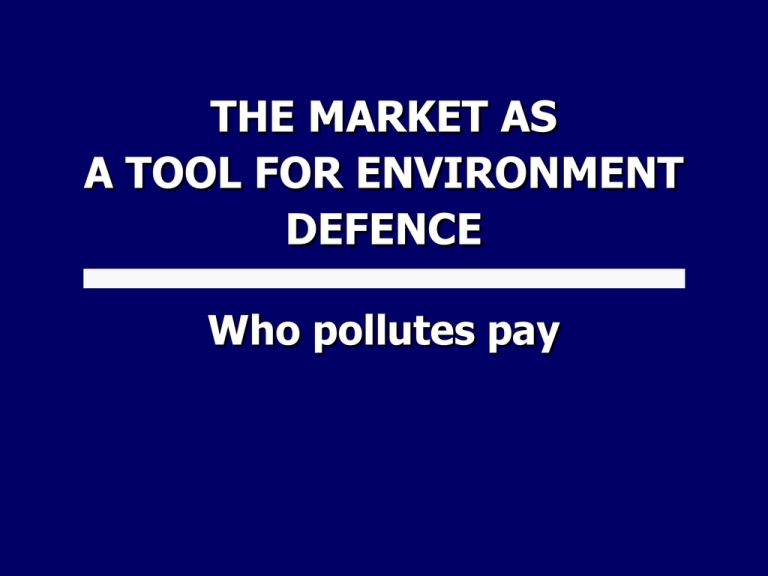eia-lesson 18
advertisement

THE MARKET AS A TOOL FOR ENVIRONMENT DEFENCE Who pollutes pay 1. THE MARKET AS A SYSTEM LIMITS: Recalls 2. THE MARKET AS A SYSTEM FOR ENVIRONMENTAL DEFENCE 2.1 The ineffectiveness of the command and control methods 2.2 The market incentives 2.3 The PIP 2.4 The perfect level of pollution 3. THE RESOURCE LIMITS TO THE MARKET As we know, generally the mechanism of market, however efficient in many contexts, in the case of environmental property induces an excessive consumption of those resources whose price is nil or inferior to the social cost How is it possible “to restructure” the system of the market exchanges in a way to assure a most efficient management of the environmental resources? To pass the resource through the market (tariff of access, laws of buying / selling) Interfere the market “from the top“ modifying the prices of the environmental resources use (incentives based on the market) The market incentives are alternative solution, method of command and control fixation of standard authority and prohibitions that the economic agents have the obligation to respect. Many economists sustain that the command and control method is inefficient for the following reasons: If we returned to the market, we could raise this knowledge modifying the calculation of polluters, without necessity to acquire information directly ! Every polluter sustains different costs to reduce his pollution Fixing a standard is done of “every grass a bundle” imposing valid rules for everybody. The market recourse would allow every one to grade his level of pollution according to his cost structure, suggesting the efficient formalities to reduce the pollution. The market resource consists in fact of the creation of a system of burdens that allows everyone to choose how to conform to the standard of environmental quality. Who can avoid polluting resorting to alternative technologies with reasonable costs … The state has to fix rules and to verify its following The efficient polluters will prefer to pay the tax or to close instead The market resource is particularly attractive as more the economic system is complex and how much higher they would be the (bureaucratic) cost of acquisition…. … And for information elaboration from a public authority that want to check the activity of every agent directly . FUNDAMENTAL PRINCIPLE OF ENVIRONMENTAL POLICY OF THE OCSE (Organization for Economic Cooperation and Development): who pollutes pay (PIP) , or … … The market price of a property or service must reflect its total cost of production or the cost of all resources utilized In this sense, the use - and therefore the deterioration of the air, of water or of any other natural resource must be valued from the fact that such resources exits in market ! The PIP forces the polluters To internalize the costs of the used resources and therefore To economize the use Naturally, because this is feasible to international level a notable coordination is needed : applying such measures would reduce in fact the competitiveness regarding the economics that they don’t do! And also possible exceptions related to contingent reasons should be very limited and temporary… The PIP has been known from European Economic Community since 1975. If the polluters must take into consideration real environmental damages produced by its activity… He will have incentive to reduce the damage to the level in which the marginal cost of the reduction of the pollution becomes equal to the marginal cost of the damage provoked by the pollution By this we will reach the perfect level of pollution (generally positive) While usually the producer care about the difference between his private marginal profit and his private marginal cost continuing to produce until this difference remains positive … … Now it is necessary that such difference is not only positive but also superior to the cost of pollution for every united date if the enterprise bears such cost! However, how do we apply this logic to the emission of dangerous substances that maintain their harmful effects in time ? How to keep track of the complicated interactions between more harmful substances emerged contemporarily from one or more manufacturer ? How to identify quickly the polluting emissions recognizing its harmful nature that cause appreciable or environmental danger ? Also, measuring the exact economic cost of a polluting emission is very difficult. In practice it is determined at a rate of constant emission for every pollution unit Finally, the principle can be interpreted more extensively taking into account great or small measure of the complex of the environmental relapses of a polluting emission. A modern economic system and unfortunately incompatible with the idea of a void environmental risk. We have to operate an acceptable compromise between costs and benefits of the pollution. The approaches more followed are two: The principle precaution Analysis cost – benefit



